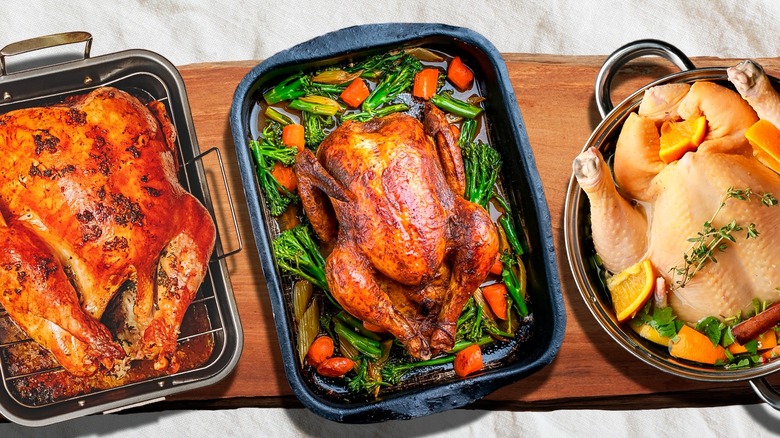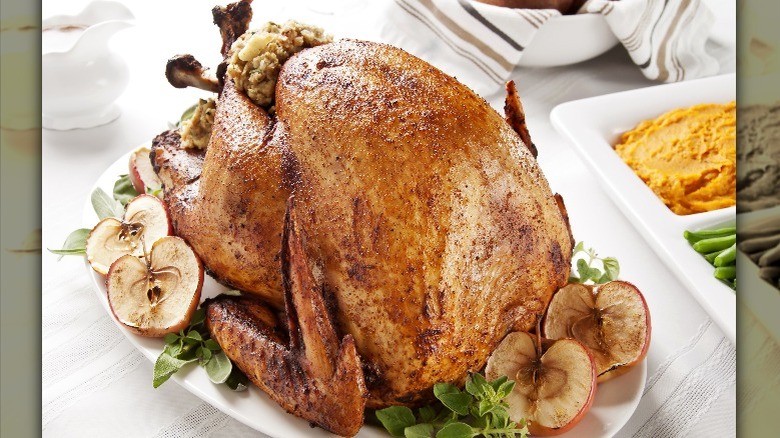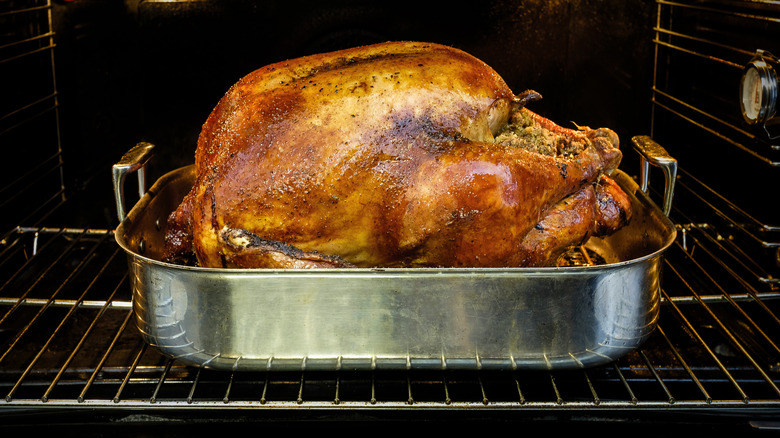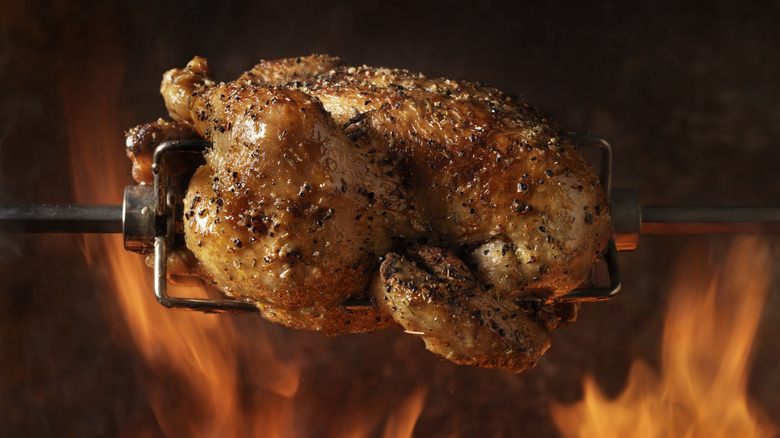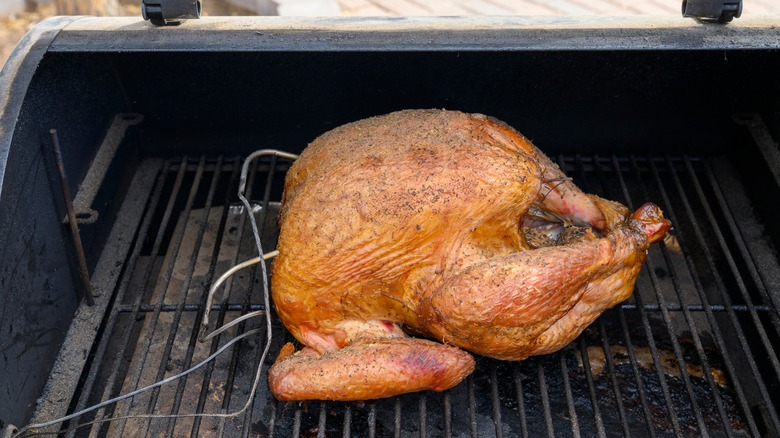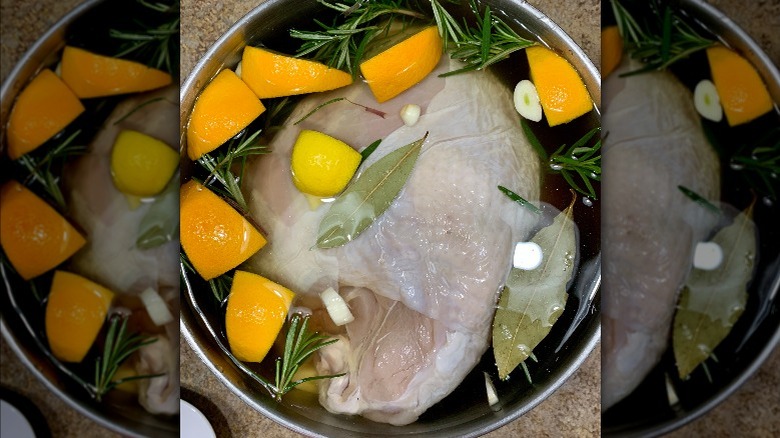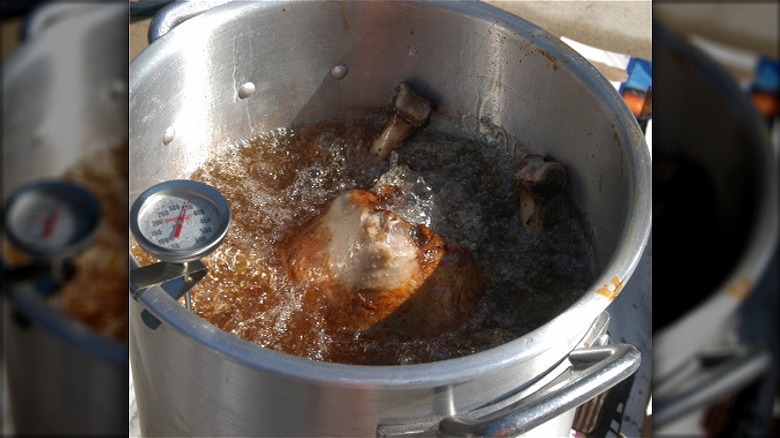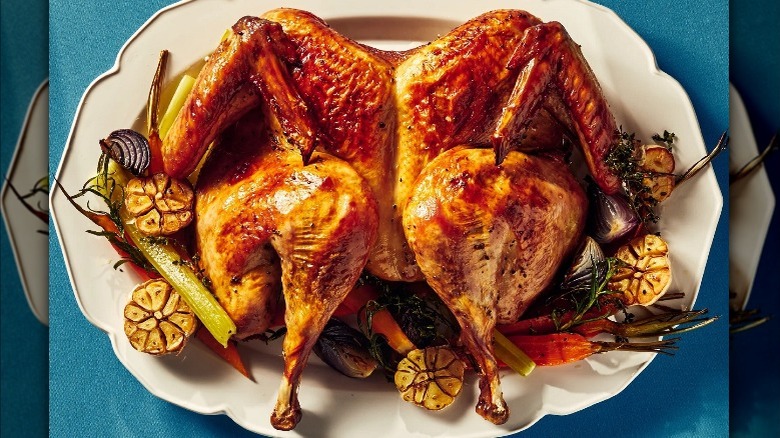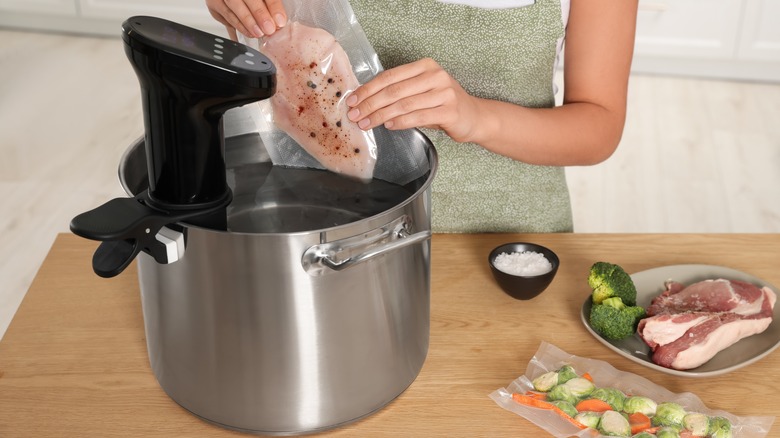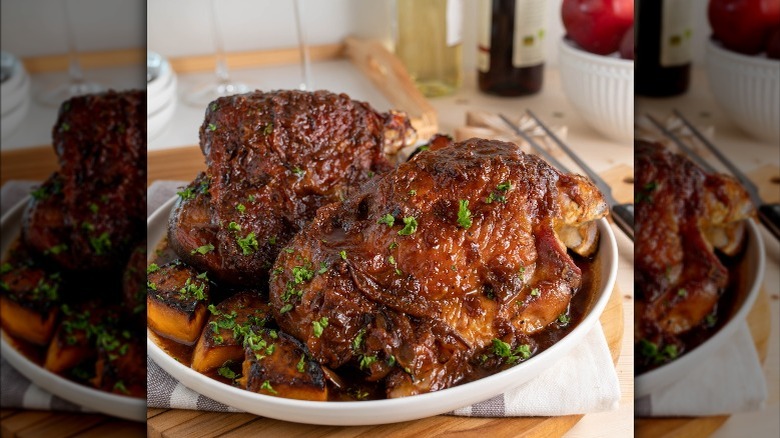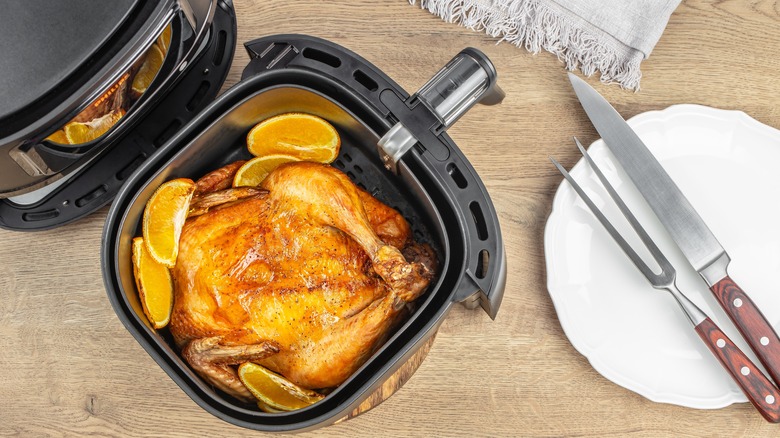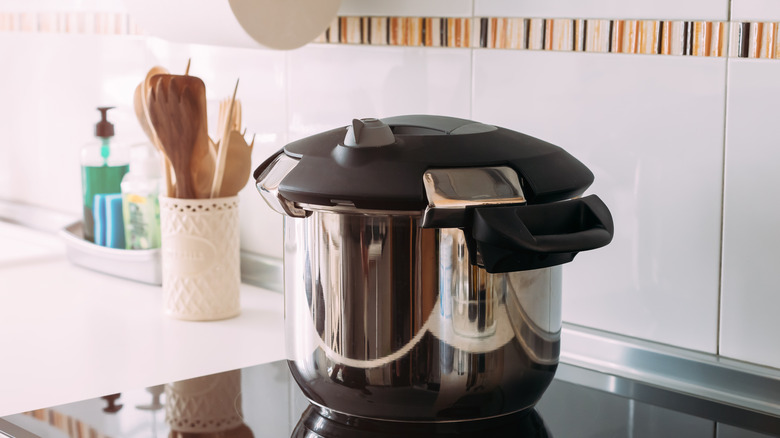Here's Every Way You Can Cook That Thanksgiving Turkey
It's almost turkey time again. Thanksgiving is right around the corner, and now's the time to be thinking about how you want to cook that bird. The most traditional way to cook a Thanksgiving turkey is to roast it in the oven. Maybe you or a family member have gotten up in the wee hours of the morning to pop the turkey in the oven so it would be done by the time friends and family gathered for the Thanksgiving feast. But gone are the days that this is your only option for achieving a delicious tasting turkey. From frying to grilling, there are about a dozen ways to cook a Thanksgiving turkey.
We caught up with executive chef and restaurateur Brad Wise, who owns the Trust Restaurant Group in Southern California, to dive into the best methods and tips for making the star of your holiday table the showstopping centerpiece it should be. Though he tells us, "I don't mess with the classic way to make turkey," Wise also shares his turkey-cooking expertise so you can determine which way you prefer to impress your guests.
No matter how you choose to cook your turkey, he strongly suggests using all parts of the turkey. This will help to cut down on waste and make the most of the money you spent.
Stuffed
"To stuff or not to stuff?" It's quite the popular question when it comes to a Thanksgiving turkey. However, stuffed or unstuffed can depend on how you plan to cook it. It's not recommended to stuff a turkey if you're going to deep fry it, but if you're going the classic way of roasting the bird, chef Brad Wise says, "Stuff your bird before cooking it."
Whatever you stuff your turkey with will contribute to its flavor and seasoning. From bread or meat to produce like onions, carrots, lemon, or orange, you can get quite creative when it comes to stuffing a turkey. "I make an Italian sausage stuffing every year," Wise tells us. "The recipe is my mom's. The drippings from the turkey added to the flavor of the stuffing help keep the turkey moist, plus add flavors and aromatics."
If you opt not to stuff the turkey, consider creating a dressing as a side dish. What's the difference between stuffing and dressing? Mostly, it's how the ingredients get cooked — stuffing, inside the turkey's hollow cavity; and dressing, separately. But it's not uncommon to craft both versions, either because of excess stuffing makings or in order to have a variety of different but complementary flavor profiles. Serving both stuffing and dressing is particularly common in families who have multiple family recipes that feature three or four versions of stuffing.
Roasted
Roasted turkey is the very picture of Thanksgiving and perhaps the most common way to have it prepared. As previously mentioned, this method is also chef Brad Wise's favorite way to cook his Thanksgiving turkey. "I love a good oven roasting bag," he tells us. "Reynolds — it's the best — it keeps the turkey moist while roasting it."
Indeed, the main risk for roasting turkey, Wise says, is the meat becoming too dry, especially the white meat. By keeping the turkey covered while cooking it in the oven, you trap the rising steam in the bag, which creates excess moisture and yields what Wise considers to be the best turkey. "I've cooked turkey a hundred different ways, and I always find myself returning to the tried-and-true bag method to ensure the most juicy, flavorful turkey," he explains. "Old school I know, but it works. I swear."
Still, there are a variety of ways to roast a turkey, covered or uncovered. But no matter which way you choose to roast it, be ready days ahead of time. Roasting is typically considered a low-and-slow cooking method. Cooking a perfect turkey requires multiple steps, including prep work from choosing the right size to knowing how long it will take the bird to cook. Be sure to fully thaw your turkey and ensure enough cooking time before you plan to sit down and eat it.
Grilled
For those who spend Thanksgiving in a warmer climate or are among the many who cook out no matter what the weather is, grilling is another cooking option for your Thanksgiving turkey. What better way to celebrate the holiday than by cooking over an open fire? Grilling achieves a crispy, charred exterior that gives the turkey meat a deeper, heartier bite. As an added bonus: You won't heat up the kitchen and potentially overheat your guests if you opt for this cooking method.
But before you go this route, make sure the size of the turkey you need fits well on your grill and that you can safely close the lid. When you prep the turkey before grilling it, be generous with a good cooking fat like butter or olive oil, which aids in the meat retaining moisture and the skin becoming crispy and caramelized. A convenient way to grill your Thanksgiving turkey is to get yourself a rotisserie attachment. The rotisserie rod, such as this popular Char-Broil Universal Electric Rotisserie on Amazon, does all of the work for you, as it slowly spins the turkey round and round so it bastes itself while cooking.
Grilling a turkey takes roughly a few hours. But much like your oven, your grill offers you the chance to cook other dishes at the same time, like stuffing or potatoes.
Smoked
Just like you can grill your Thanksgiving turkey, you can smoke it, too. Of course, this method requires a smoker large enough for your bird. However, not only do you obtain the flavor of flame grilled, but you also get a turkey kissed with seasoned wood that only enhances the bird's taste. Woods for smoking, like alder, pecan, peach, and oak, complement turkey by adding an underlying nutty or fruity taste without overpowering the meat's more delicate nature.
That said, if you don't have a smoker, we've got you covered there, too — with tips on how to make a smoke-brined turkey. For this, you just need liquid smoke, which you can add to your brining liquid, so the turkey absorbs the smokiness. Then, you can roast it in the oven in the traditional manner.
But even if you don't smoke your Thanksgiving turkey, consider this method for your leftovers. "Don't toss your carcass," chef Brad Wise suggests, explaining that you should instead make stock with it. So, before you throw out the bones, smoke them. This additional step adds depth and flavor to your stock, Wise tells us. "I would cold-smoke the whole thing for a few hours, enough to let it take on some of the flavors of the smoker and the wood you're burning," he says. "Then, boil the carcass, and go about making stock as you would."
Brined
Brining may not be an actual cooking method, but it is a popular prepping method that can drastically change how your turkey is cooked. Brining is either wet or dry, and it works to add flavor and moisture to the food you're cooking. Both variations require salt, which is the key factor to pulling moisture into the meat. A wet brine calls for submerging your turkey in a seasoned, salty solution, so make sure your pot is large enough to hold a large amount of liquid — water or broth — as well as the turkey.
Chef Brad Wise tells us he's not the biggest fan of wet brining his turkey, but he does like to use a dry rub. A dry brine features your seasoned salt on the surface of your meat. It pulls moisture out, which is then reabsorbed back into the meat, taking the seasoned flavors of the salt rub with it, and infusing the bird with additional flavor and moisture. The purpose of brining is to create tender meat while boosting flavor.
But if you choose not to brine, pay close attention to your gravy. For that additional umami topping, Wise suggests using the giblets and neck to help make the gravy. "Adding these parts creates this thicker, richer, darker gravy that's good," he says.
Deep fried
Deep frying a turkey may sound intriguing and yet terrifying at the same time. The sheer size of a whole turkey and the amount of frying oil needed is enough to make anyone think twice about cooking their Thanksgiving turkey this way. And indeed, good sense says you should think twice about deep frying your turkey. It can be dangerous, says chef Brad Wise, who notes, "The obvious cons are injury and/or damage to your house." In fact, doing it wrong can cause a major catastrophe, according to the U.S. Consumer Product Safety Commission.
In order to perform this cooking method correctly, follow the directions of your deep fryer, make sure the bird is fully thawed, and keep the oil shallow enough so it doesn't overflow when you gently place the turkey in the fryer. Deep fry that turkey correctly and safely, and Wise tells us, "It's delicious."
To deep fry an entire turkey, use the general rule of three to four minutes per pound of bird. For instance, a 12- to 15-pound turkey should take approximately 40 minutes to an hour to finish cooking. An alternative — and perhaps safer method for deep-fried turkey — involves frying your turkey in parts instead of as a whole. This can reduce your cooking time and create less of a risky mess. Plus, you can customize cooking time for white and dark meat separately, so each are cooked perfectly, and you'll decrease the risk of over- or under-cooking a portion of the turkey.
Spatchcocked
Despite the complex-sounding term, spatchcock refers to a specific cutting technique that enables you to cook poultry flat. It may not present the same as a roasted turkey in its original form, and therefore may not make as grand a showing on your Thanksgiving table spread, but cooking the bird flat helps all areas of it to cook more evenly, chef Brad Wise tells us. Spatchcocking, then, also allows for a more consistent cook across both white and dark meat.
This method works especially well if you're going to smoke the turkey, but spatchcocking can also be used for roasting, grilling, or braising. Because of how the turkey is spread out, it ends up closer to the heating surface, so your cooking time is quicker, too.
Though the term and definition give the impression that spatchcocking is a skill, it's actually a simple procedure; you're just removing the backbone. The easiest and best way to do this, Wise explains, is to use scissors to cut the backbone out. A sturdy pair of kitchen shears — the scissors that often come with your kitchen knife set — is all you need to get the job done. To spatchcock a turkey for Thanksgiving, flip the bird over so you have access to the backbone and use the shears to cut around it. Remove the backbone and save it for stock. Flip the turkey back over to spread it out and press it flat before cooking.
Sous vide
Sous vide is a popular method for slow cooking meat, though it's typically meant for individual servings and not entire meals. This French cooking method refers to food that is vacuum sealed in a plastic bag, which is then cooked at a low temperature. The sealed bag is placed in a pot of water, where the temperature is regulated by a sous vide machine. Once you've set the temperature of the water, your food cooks consistently for the desired amount of time. Sous vide results in gentle, even cooking without the result of waterlogged or Sahara-like food.
Chef Brad Wise tells us sous vide could be a good consideration for your Thanksgiving turkey. You'll just have to find a cooking vessel big enough to hold a large amount of water, plus a plastic bag large enough to seal a whole turkey. However, he warns it could be a lot of steps to achieve a moist, tender bird. A great alternative and far more practical way is cutting the turkey into pieces in order to sous vide it. Just don't make these sous vide mistakes if you do. Once the turkey has finished cooking, sear it under the broiler or on the stovetop or grill to achieve a crispy, caramelized exterior.
Braised
Braising is a low-and-slow cooking method that's similar to roasting, except it requires cooking food — in this case, your Thanksgiving turkey — in liquid. Your turkey rests in at least a few inches of water or broth to help keep the bird moist while it cooks. Spices and herbs are typically added to a braising liquid to impart subtle flavors and seasoning. You can even add other foods like carrots, onions, garlic, lemon, or oranges to your liquid base, so they simmer with the turkey. Though it's common to sear meat before or after braising, it doesn't achieve the same crispy, caramelized skin on the turkey as you see with a dry roast.
Depending on the tastes and textures of the turkey you're looking to bring to the table, braising may or may not be a worthwhile choice for you. Chef Brad Wise tells us he wouldn't braise a Thanksgiving turkey, adding, "I lean toward the tried-and-true oven roasting method." But if you're interested in trying your hand at braising turkey, consider braising it spatchcock style or carve it into multiple large pieces instead of braising it whole. Add in root vegetables, make a side of stuffing or dressing, and you've got yourself an easy Thanksgiving meal.
Air fried
With the risks and hazards that can potentially arise from deep frying a turkey in a large vat of hot oil, consider air frying for a far less messy or dangerous cooking affair. Similarly to braising, Chef Brad Wise also doesn't recommend this method for your holiday bird. Still, air fryers are made to safely use in your kitchen. Requiring little to no oil, you can get crispy, golden skin on your turkey without the hassle of using gallons of oil. Air frying is a much safer option that gives you the opportunity to experiment with your Thanksgiving turkey without burning down your house in the process. Frying without oil also makes for a quick and easy cleanup.
While most deep fryers can accommodate turkeys up to 20 pounds, air fryers — especially the common basket-style ones — tend to run smaller, so you'll need to crosscheck both the dimensions of your air fryer against the turkey's size and weight to make sure it will fit properly. There are a wide variety of oil-less fryers, sold under a range of terms — electric, air fry, and oil-free. Just be sure to read the instructions carefully before using one.
Instead of frying in hot oil, an air fryer circulates hot air using fans, emulating the result of food typically fried in oil. You get a moist inside and crispy outside. At least, that's the idea. Of course, frying with oil and without oil yields two different results. But even if you opt for a different cooking method, you can also reheat your leftover turkey in an air fryer.
Pressure cooked
Pressure cooking used to be a lot more daunting to tackle and less commonly used as a way to cook most foods. A large number of kitchen appliances and gadgets have created new twists on old favorites, and certain cooking methods have found their way back into kitchens. You no longer have to use a loud and clunky metal contraption that was infamous for giving steam burns. Modern pressure cookers like the Instant Pot make it easier and safer to cook food under pressure. Becoming instantly popular, pressure cookers are now loved for how easy they are to use. All of a sudden, it's not out of the question to pressure cook a turkey.
If you're curious about cooking your Thanksgiving turkey with a pressure cooker, you wouldn't be alone. We were wondering if this method was a valid option or something worthy of an attempt. "I've never pressure-cooked a turkey," chef Brad Wise tells us, "so I can't really speak to if it's a good idea or not." Pressure cooking can certainly cut down on the amount of time you need to cook your turkey, but you have to have a pressure cooker that's large enough to handle a big bird.
Wise again suggests sticking to the oven as your cooking method instead. After all, arguably nothing beats a classically roasted Thanksgiving turkey.
